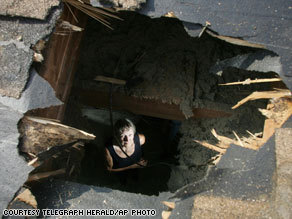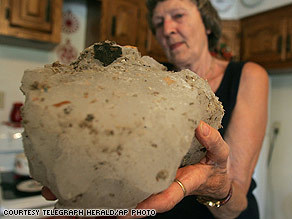

| Visitors Now: | |
| Total Visits: | |
| Total Stories: |

| Story Views | |
| Now: | |
| Last Hour: | |
| Last 24 Hours: | |
| Total: | |
Old Shocking News … 50 + pound Ice Chunks Fall From Sky

above photo found HERE
I consider the possibility of small droplets of water being held between pressurized points of atmosphere … and in time do spin and condense these droplets until their bulk state can no longer be supported by their upper barriers of flowing high frequency energy streams … sort of like the formation of normal hail chunks of ice but having to do with falling through higher dimensional atmospheric flow of quantum energy …
Yet these falling SHEETS of ice are a different celestial story …
HERE Associated Press
Fri, 27 Jul 2007 10:25 CDT
Authorities were unsure of the ice’s origin but have theorized the chunks either fell from an airplane or naturally accumulated high in the atmosphere – both rare occurrences.
 |
| ©Herald Tribune/AP |
“It sounded like a bomb!” 78-year-old Jan Kenkel said. She said she was standing in her kitchen when an ice chunk crashed through her roof at about 5:30 a.m. More HERE HERE June 26, 1985. Hartford, Connecticut.
“Scientists yesterday tried to determine the origin of a 1500-pound sheet of ice that mysteriously dropped from the sky and smashed into a backyard fence. David H. Menke, directory of the Copernican Observatory and Planetarium, said the ice was probably 6 feet long, 8 inches thick and moving at about 200 mph. ‘It’s unusual in the fact that it fell from the sky,’ said Craig Robinson, curator at the planetarium. ‘That does not happen often.’ A 13year-old boy was in his backyard Monday with a friend when the ice came ‘whirling’ from the sky and smashed into the fence about 10 feet away from them.”
HERE Wikipedia … A megacryometeor is a very large chunk of ice which, despite sharing many textural, hydro-chemical and isotopic features detected in large hailstones, is formed under unusual atmospheric conditions which clearly differ from those of the cumulonimbus cloud scenario (i.e. clear-sky conditions). They are sometimes called huge hailstones, but do not need to form in thunderstorms. Jesus Martinez-Frias, a planetary geologist at the Center for Astrobiology in Madrid, pioneered research into megacryometeors in January 2000 after ice chunks weighing up to 6.6 pounds (3.0 kg) rained on Spain out of cloudless skies for ten days. An ice chunk was discovered in el kmeysat, Morocco in a farmers field in December 2012.



